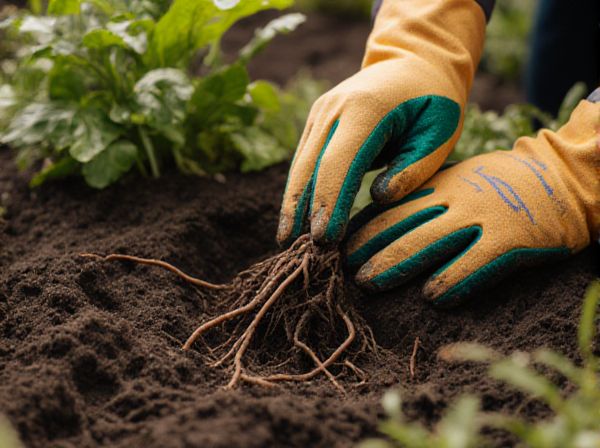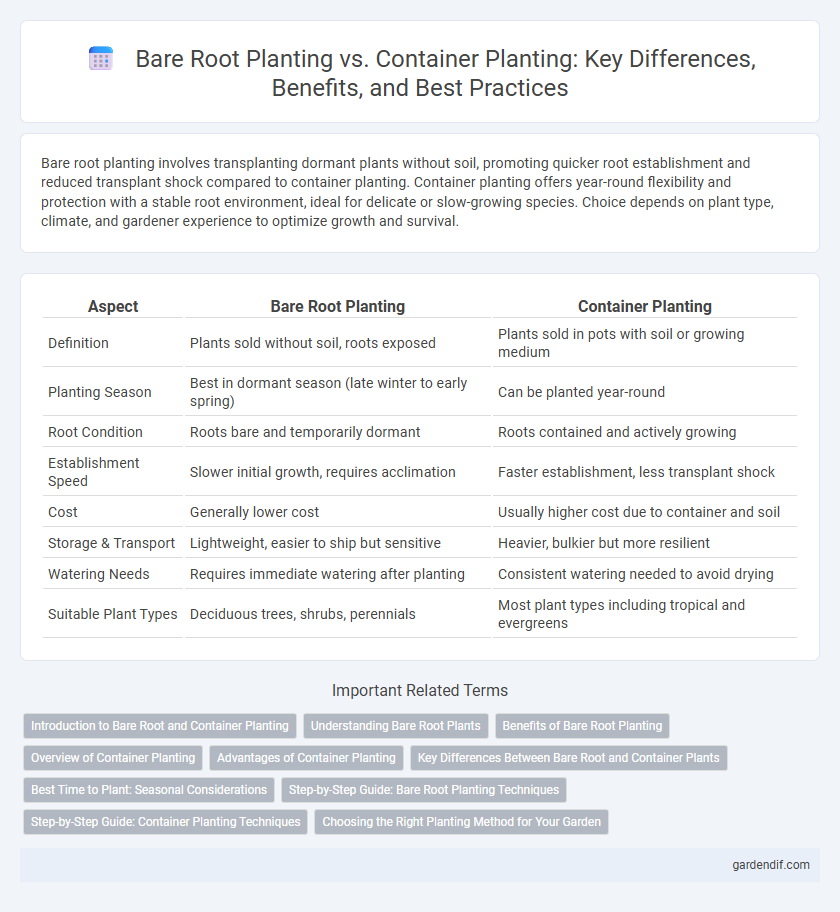
Bare root planting vs Container planting Illustration
Bare root planting involves transplanting dormant plants without soil, promoting quicker root establishment and reduced transplant shock compared to container planting. Container planting offers year-round flexibility and protection with a stable root environment, ideal for delicate or slow-growing species. Choice depends on plant type, climate, and gardener experience to optimize growth and survival.
Table of Comparison
| Aspect | Bare Root Planting | Container Planting |
|---|---|---|
| Definition | Plants sold without soil, roots exposed | Plants sold in pots with soil or growing medium |
| Planting Season | Best in dormant season (late winter to early spring) | Can be planted year-round |
| Root Condition | Roots bare and temporarily dormant | Roots contained and actively growing |
| Establishment Speed | Slower initial growth, requires acclimation | Faster establishment, less transplant shock |
| Cost | Generally lower cost | Usually higher cost due to container and soil |
| Storage & Transport | Lightweight, easier to ship but sensitive | Heavier, bulkier but more resilient |
| Watering Needs | Requires immediate watering after planting | Consistent watering needed to avoid drying |
| Suitable Plant Types | Deciduous trees, shrubs, perennials | Most plant types including tropical and evergreens |
Introduction to Bare Root and Container Planting
Bare root planting involves transplanting plants with their roots exposed, typically during dormancy, which reduces transplant shock and lowers shipping costs. Container planting uses plants grown in pots, allowing for year-round planting flexibility and immediate root establishment in the soil. Both methods have distinct advantages depending on plant species, climate, and planting time, influencing growth success and maintenance requirements.
Understanding Bare Root Plants
Bare root planting involves transplanting plants that have been removed from the soil while dormant, with their roots exposed and bare, allowing for easier inspection and treatment of root diseases. This method typically reduces transplant shock, promotes faster establishment, and is cost-effective for shipping and handling compared to container planting, where plants remain in soil-filled pots. Understanding the proper handling and timely planting of bare root plants is essential to ensure optimal growth and survival during transplanting.
Benefits of Bare Root Planting
Bare root planting offers significant benefits including lower initial costs and easier transportation due to the absence of bulky soil, enabling more efficient handling and storage. This method promotes better root establishment as roots spread directly into the soil without restrictions from a container, enhancing plant growth and survival rates. Additionally, bare root plants generally experience less transplant shock, resulting in faster adaptation and healthier development.
Overview of Container Planting
Container planting offers greater control over soil quality, drainage, and moisture levels compared to bare root planting, allowing plants to establish roots more effectively before transplanting. This method reduces transplant shock by maintaining the root ball intact within the container, facilitating healthier growth and higher survival rates. Container planting is ideal for a wide range of plants, especially when immediate planting is not possible or when precise root environment management is necessary.
Advantages of Container Planting
Container planting ensures consistent moisture retention and reduces transplant shock by preserving the root ball intact. It allows for extended planting seasons and easier handling, promoting better establishment and growth. This method also minimizes root disturbance, leading to higher survival rates and healthier plants compared to bare root planting.
Key Differences Between Bare Root and Container Plants
Bare root plants are sold without soil, with roots exposed and dormant, making them lightweight and cost-effective for shipping, while container plants grow in soil-filled pots, allowing roots to develop in a controlled environment prior to transplanting. Bare root planting requires immediate installation during the dormant season to reduce transplant shock, whereas container planting offers year-round flexibility and a higher survival rate due to established root systems. Key differences include root exposure, planting timing, handling ease, and transplant success rates, with container plants generally having an advantage in adaptability and maintenance.
Best Time to Plant: Seasonal Considerations
Bare root planting is best done during the plant's dormant season, typically late fall to early spring, when roots are less stressed by heat and drought. Container planting allows for extended planting seasons since plants are grown in a controlled environment and can be established any time the ground is workable. Seasonal temperature and moisture levels directly impact root establishment and overall plant survival rates in both methods.
Step-by-Step Guide: Bare Root Planting Techniques
Bare root planting involves transplanting plants without soil, focusing on soaking roots in water for several hours before planting to ensure hydration. Dig a hole twice as wide as the root system, spread the roots evenly, and backfill with nutrient-rich soil, ensuring the plant is set at ground level for optimal growth. Regular watering after planting is crucial to establish roots and improve plant survival rates compared to container planting.
Step-by-Step Guide: Container Planting Techniques
Container planting involves selecting a pot with adequate drainage holes and filling it with high-quality, well-draining potting mix suitable for the specific plant species. Position the plant carefully, spreading the roots evenly before covering them with soil, ensuring the root collar is at soil level to prevent rot. Water thoroughly after planting and place the container in an environment that meets the plant's sunlight and temperature requirements.
Choosing the Right Planting Method for Your Garden
Bare root planting offers budget-friendly options with fast root establishment and is ideal for dormant plants during early spring. Container planting ensures year-round availability, reduced transplant shock, and flexibility in planting timing, suitable for delicate or tropical species. Selecting the right method depends on plant type, garden climate, and desired growth speed to maximize plant health and garden success.
Bare root planting vs Container planting Infographic

 gardendif.com
gardendif.com